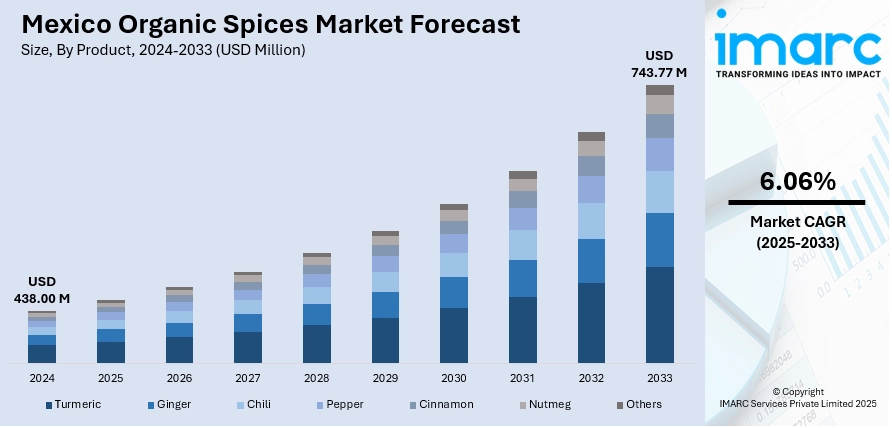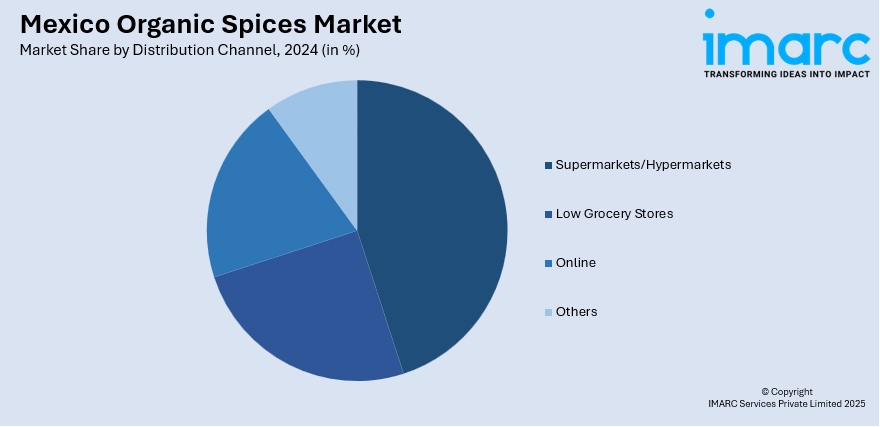
Mexico Organic Spices Market Size, Share, Trends and Forecast by Product, Form, Distribution Channel, and Region, 2026-2034
Mexico Organic Spices Market Overview:
The Mexico organic spices market size reached USD 438.00 Million in 2025. Looking forward, IMARC Group expects the market to reach USD 743.77 Million by 2034, exhibiting a growth rate (CAGR) of 6.06% during 2026-2034. The market is driven by growing health consciousness, urbanization, and increased demand for clean-label, natural food ingredients. Consumers are embracing plant-based, additive-free flavors and seeking sustainable sourcing, prompting innovation in spice blends and farming practices. This shift supports expansion in both retail and foodservice channels, reinforcing the Mexico organic spices market share.
|
Report Attribute
|
Key Statistics
|
|---|---|
|
Base Year
|
2025 |
|
Forecast Years
|
2026-2034
|
|
Historical Years
|
2020-2025
|
| Market Size in 2025 | USD 438.00 Million |
| Market Forecast in 2034 | USD 743.77 Million |
| Market Growth Rate 2026-2034 | 6.06% |
Mexico Organic Spices Market Trends:
Rising Health Consciousness and Wellness Trends
Mexico’s growing awareness of health and nutrition is propelling the organic spices market. Consumers are increasingly recognizing the benefits of additive-free, pesticide-free ingredients and are actively shifting toward more healthful alternatives. Organic spices, with their enhanced antioxidant content and lack of chemical residues, align with consumer demands for “clean label” and functional foods. This trend is evident in everyday cooking styles leaning toward natural, wholesome flavors. As more people focus on dietary wellness, especially with concerns around digestion, immunity, and chronic disease, organic spices are perceived not just as seasoning, but as health enablers. This health-first mindset is reshaping purchase behaviors and encouraging brands to invest in organic spice production and certification programs.

To get more information on this market, Request Sample
Sustainability, Ethical Sourcing, and Environmental Awareness
Sustainability concerns are a key factor driving the Mexico organic spices market growth. Consumers increasingly demand products grown through eco-friendly methods, such as organic fertilizers and biodiversity-friendly practices. Organic agriculture promotes soil health and reduces pollution, resonating with ethically minded buyers and supporting rural communities. Additionally, government support and incentives for organic farming are helping expand cultivation area, boosting supplies of organic spices like turmeric, chili, and garlic. Brands are embedding sustainability into sourcing narratives, emphasizing traceability and fair trade. This eco-conscious approach not only meets regulatory and consumer expectations but also strengthens brand reputation, drives loyalty, and encourages investment in sustainable supply chains.
Urbanization, Income Growth, and Culinary Experimentation
Rapid urbanization and rising disposable incomes in Mexico are fueling the demand for organic spices. City dwellers have greater access to specialty retailers, farmers’ markets, and grocery chains that stock organic options. With urban lifestyles exposing consumers to diverse cuisines, there’s growing interest in exploring bold, natural flavors. This culinary curiosity, driven by international travel and exposure to global food trends, encourages experimentation with organic turmeric, chili, garlic, and other spices. As a result, households are incorporating a wider range of seasonings into daily cooking. Brands and retailers are responding with product innovation, launching spice blends, specialty blends, and convenient formats to cater to this evolving palate.
Mexico Organic Spices Market Segmentation:
IMARC Group provides an analysis of the key trends in each segment of the market, along with forecasts at the country and regional levels for 2026-2034. Our report has categorized the market based on product, form, and distribution channel.
Product Insights:
- Turmeric
- Ginger
- Chili
- Pepper
- Cinnamon
- Nutmeg
- Others
A detailed breakup and analysis of the market based on the product have also been provided in the report. This includes turmeric, ginger, chili, pepper, cinnamon, nutmeg, and others.
Form Insights:
- Powder
- Whole
- Chopped/Crushed
The report has provided a detailed breakup and analysis of the market based on the form. This includes powder, whole, and chopped/crushed.
Distribution Channel Insights:

- Supermarkets/Hypermarkets
- Local Grocery Stores
- Online
- Others
A detailed breakup and analysis of the market based on the distribution channel have also been provided in the report. This includes supermarkets/hypermarkets, local grocery stores, online, and others.
Regional Insights:
- Northern Mexico
- Central Mexico
- Southern Mexico
- Others
The report has also provided a comprehensive analysis of all the major regional markets, which include Northern Mexico, Central Mexico, Southern Mexico, and others.
Competitive Landscape:
The market research report has also provided a comprehensive analysis of the competitive landscape. Competitive analysis such as market structure, key player positioning, top winning strategies, competitive dashboard, and company evaluation quadrant has been covered in the report. Also, detailed profiles of all major companies have been provided.
Mexico Organic Spices Market Report Coverage:
| Report Features | Details |
|---|---|
| Base Year of the Analysis | 2025 |
| Historical Period | 2020-2025 |
| Forecast Period | 2026-2034 |
| Units | Million USD |
| Scope of the Report |
Exploration of Historical Trends and Market Outlook, Industry Catalysts and Challenges, Segment-Wise Historical and Future Market Assessment:
|
| Products Covered | Turmeric, Ginger, Chili, Pepper, Cinnamon, Nutmeg, Others |
| Forms Covered | Powder, Whole, Chopped/ Crushed |
| Distribution Channels Covered | Supermarkets/Hypermarkets, Local Grocery Stores, Online, Others |
| Regions Covered | Northern Mexico, Central Mexico, Southern Mexico, Others |
| Customization Scope | 10% Free Customization |
| Post-Sale Analyst Support | 10-12 Weeks |
| Delivery Format | PDF and Excel through Email (We can also provide the editable version of the report in PPT/Word format on special request) |
Key Questions Answered in This Report:
- How has the Mexico organic spices market performed so far and how will it perform in the coming years?
- What is the breakup of the Mexico organic spices market on the basis of product?
- What is the breakup of the Mexico organic spices market on the basis of form?
- What is the breakup of the Mexico organic spices market on the basis of distribution channel?
- What is the breakup of the Mexico organic spices market on the basis of region?
- What are the various stages in the value chain of the Mexico organic spices market?
- What are the key driving factors and challenges in the Mexico organic spices market?
- What is the structure of the Mexico organic spices market and who are the key players?
- What is the degree of competition in the Mexico organic spices market?
Key Benefits for Stakeholders:
- IMARC’s industry report offers a comprehensive quantitative analysis of various market segments, historical and current market trends, market forecasts, and dynamics of the Mexico organic spices market from 2020-2034.
- The research report provides the latest information on the market drivers, challenges, and opportunities in the Mexico organic spices market.
- Porter's five forces analysis assist stakeholders in assessing the impact of new entrants, competitive rivalry, supplier power, buyer power, and the threat of substitution. It helps stakeholders to analyze the level of competition within the Mexico organic spices industry and its attractiveness.
- Competitive landscape allows stakeholders to understand their competitive environment and provides an insight into the current positions of key players in the market.
Need more help?
- Speak to our experienced analysts for insights on the current market scenarios.
- Include additional segments and countries to customize the report as per your requirement.
- Gain an unparalleled competitive advantage in your domain by understanding how to utilize the report and positively impacting your operations and revenue.
- For further assistance, please connect with our analysts.
 Request Customization
Request Customization
 Speak to an Analyst
Speak to an Analyst
 Request Brochure
Request Brochure
 Inquire Before Buying
Inquire Before Buying




.webp)




.webp)












